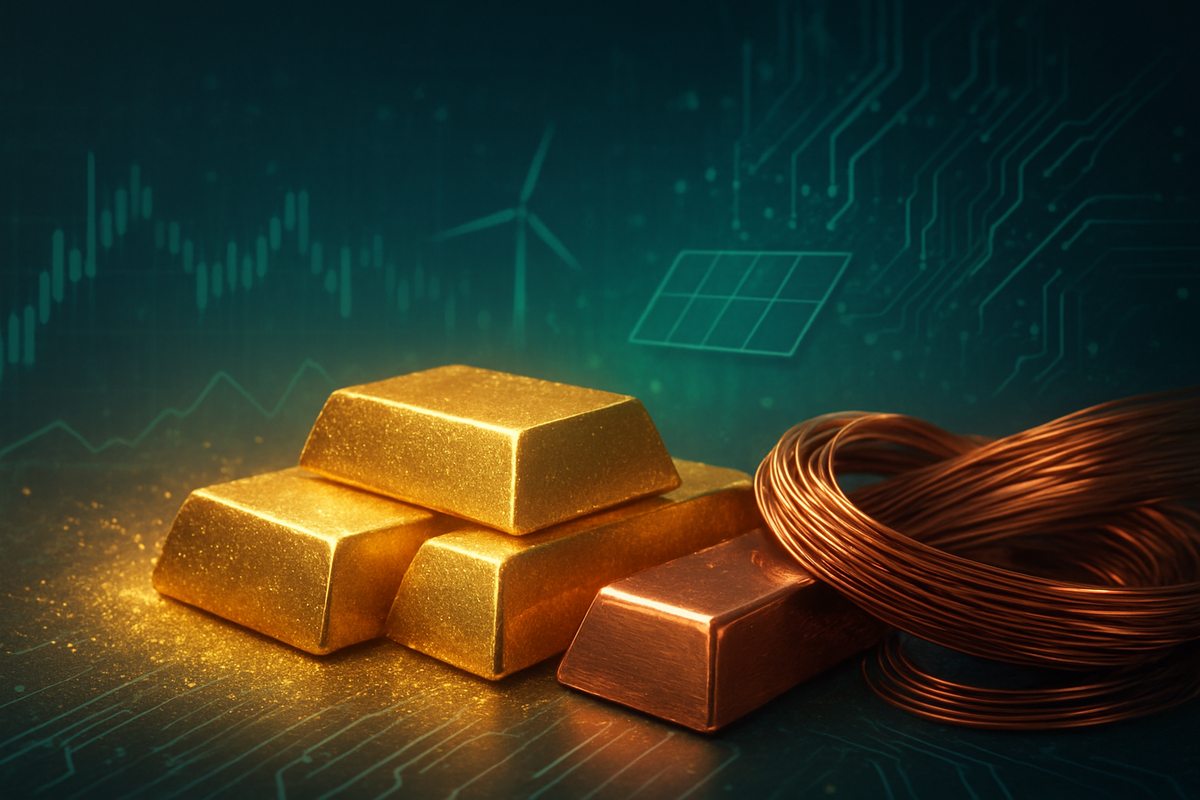
In a series of recent analyses and statements, global investment giant BlackRock has articulated a compelling argument that many investors are overlooking the profound, long-term structural forces poised to drive significant returns in both gold and copper. Despite robust performance in these commodities, BlackRock asserts that a deeper understanding of macroeconomic trends, escalating geopolitical risks, and critical supply-demand imbalances reveals a "bigger picture" that could reshape portfolios for years to come. With the current date being October 30, 2025, BlackRock's insights, primarily from October 2025 and earlier in May 2025 and April 2024, serve as a potent call to re-evaluate traditional investment theses.
The firm's conviction stems from a comprehensive view that extends beyond short-term market fluctuations, emphasizing foundational shifts that are set to underpin sustained demand and necessitate higher prices for these key commodities. For gold, BlackRock sees its role evolving beyond a mere safe haven, while copper is deemed indispensable for the twin revolutions of energy transition and artificial intelligence. This perspective suggests that the market is currently underpricing the enduring value and necessity of these metals, presenting a potential opportunity for investors who grasp these fundamental drivers.
BlackRock's Deeper Dive: Unpacking the Untapped Potential
BlackRock's detailed analysis provides distinct yet interconnected rationales for its bullish outlook on gold and copper, highlighting why current market valuations may not fully reflect their true potential.
For gold, BlackRock’s managers, including Evy Hambro, suggest its recent rally is fueled by more than just traditional safe-haven demand. Investors are increasingly concerned about government spending and national balance sheets, leading to a palpable "currency aversion" that pushes capital away from cash and government bonds into tangible assets like gold. This trend is expected to persist until governments demonstrate credible plans to address fiscal challenges. Furthermore, gold is reasserting its critical role as a hedge against geopolitical instability and currency debasement, a view reinforced by sustained demand from central banks. BlackRock also sees gold as a valuable "tactical exposure" within portfolios, noting that speculative buying has contributed to its surge. Crucially, Hambro argues that gold mining companies are currently achieving "enormous margins" and are significantly undervalued, as the market seems to be inaccurately pricing in a substantial gold price retracement that may not materialize for 12 to 24 months. This mispricing implies that gold equities are poised to "way over earn relative to expectations."
Copper, on the other hand, is identified as an indispensable linchpin for the global energy transition and the burgeoning artificial intelligence (AI) revolution. BlackRock emphasizes that the build-out of future energy infrastructure, the shift to renewables, and the massive expansion of AI and data centers are simply impossible without substantial copper supply. Olivia Markham, co-manager of the BlackRock World Mining Fund, highlights a severe and unprecedented shortage of mined copper ore. She contends that copper prices need to reach at least $12,000 per ton—a significant jump from current levels—to incentivize the colossal investments required for new mines. This "incentive pricing" is vital to ensure a 15% post-tax return on future mining investments, without which new projects will not proceed, leading to major deficits during the energy transition. Rising production costs further underscore the necessity for higher prices to make new ventures economically viable, even as structural demand drivers persist despite localized soft patches, such as in China's construction sector.
BlackRock concludes that investors are "still underestimating the fundamental shifts at play." This oversight is attributed to several factors: an excessive focus on short-term market volatility distracting from powerful long-term trends, particularly those driven by the energy transition; the mispricing of gold mining equities due to an anticipated retracement; and a broader failure to explore the "untapped broader commodity universe" beyond current outperformers.
Companies Poised to Win or Lose in the Commodity Resurgence
BlackRock's insights have significant implications for public companies across the mining and industrial sectors. If their perspective holds true, certain entities are positioned for substantial gains, while others might face increased input costs.
Potential Winners: Gold and copper mining companies stand to benefit immensely. For gold miners, BlackRock's view of undervalued equities and "enormous margins" suggests a strong upside. Companies like Barrick Gold (NYSE: GOLD) and Newmont Corporation (NYSE: NEM), already major players, could see their valuations re-rate as the market acknowledges sustained high gold prices and their robust profitability. These companies, with established operations and potential for increased output, would be direct beneficiaries of continued strong gold prices and a re-evaluation of their stock by investors.
In the copper space, miners such as Freeport-McMoRan (NYSE: FCX), Southern Copper Corporation (NYSE: SCCO), and BHP Group (ASX: BHP), with significant copper assets, are critical to meeting future demand. If copper prices indeed ascend towards BlackRock's $12,000 per ton incentive price, these companies would experience a dramatic increase in revenue and profitability, incentivizing them to invest in new projects. This could lead to a wave of capital expenditure and potential M&A activity in the sector as companies vie for control of scarce copper resources. Furthermore, companies involved in critical mineral exploration and extraction, which BlackRock suggests are part of the "untapped broader commodity universe," could also see increased investor interest and capital allocation.
Potential Losers: Conversely, industries heavily reliant on stable or lower commodity prices for their inputs might face headwinds. Manufacturers of electrical components, construction firms, and other sectors that consume large quantities of copper could see their production costs rise significantly, potentially squeezing profit margins unless they can pass these costs onto consumers. While not explicitly mentioned as "losers," companies that fail to adapt to the energy transition or those with business models vulnerable to persistent inflation and currency debasement could find their relative attractiveness diminished as investors flock to inflation-resistant assets and critical raw materials.
Wider Significance: A Paradigm Shift in Investment
BlackRock's outlook on gold and copper is not an isolated market call; it fits squarely into broader industry trends and signals a potential paradigm shift in investment strategy, particularly concerning inflation, energy security, and technological advancement.
This perspective aligns with growing concerns about persistent inflation and the efficacy of traditional inflation hedges. In an environment where global debt levels remain high and central banks navigate complex monetary policies, gold's role as a hedge against currency debasement becomes even more pronounced. The anticipated Federal Reserve rate cuts, mentioned by BlackRock, could further bolster gold's appeal by reducing the opportunity cost of holding the non-yielding asset. Geopolitical instability, from ongoing conflicts to trade tensions, reinforces the need for diversification and tangible assets, making gold a crucial component of risk management.
For copper, its indispensable role underscores the monumental scale of the energy transition. The push towards electric vehicles, renewable energy infrastructure (solar panels, wind turbines), and the foundational build-out for AI data centers represents a structural demand shock unlike any seen before. This event has ripple effects across the entire industrial complex, influencing technology companies, utilities, and infrastructure developers. Regulatory and policy implications are significant, as governments worldwide are increasingly recognizing the strategic importance of critical minerals. Policies aimed at securing supply chains, incentivizing domestic mining, and promoting sustainable extraction practices could emerge, further shaping the landscape for copper and other critical minerals. Historically, periods of significant industrial transformation or high inflation have often been accompanied by commodity supercycles, and BlackRock's analysis suggests we may be on the cusp of another such era, where the fundamental value of raw materials is re-evaluated.
What Comes Next: Navigating the New Commodity Landscape
Looking ahead, BlackRock's perspective suggests a dynamic and potentially lucrative period for gold and copper, demanding strategic pivots from investors and companies alike.
In the short-term, while market volatility is always a factor, the underlying structural demand for copper and the persistent macroeconomic and geopolitical drivers for gold are expected to provide a strong floor for prices. Investors might see continued tactical buying in both commodities as more market participants begin to internalize BlackRock's "bigger picture." For companies, this could mean increased capital allocation towards exploration and development in the mining sector, potentially leading to a ramp-up in production capacity, though this process is inherently long-term for new mines.
In the long-term, the implications are even more profound. Copper's role in the energy transition and AI is not a fleeting trend but a foundational requirement for global economic evolution. This ensures sustained, robust demand that current supply levels are ill-equipped to meet, necessitating higher prices to stimulate new investment. Gold is likely to maintain its elevated status as a hedge against ongoing currency debasement risks and geopolitical uncertainty, serving as a permanent fixture in diversified portfolios. Market opportunities will emerge for investors in commodity-focused exchange-traded funds (ETFs), particularly those offered by firms like BlackRock (e.g., iShares funds), as well as direct equity investments in well-managed mining companies. Strategic pivots for companies might include aggressive M&A to consolidate resources, investment in innovative extraction technologies, and stronger engagement with governments to secure permits and support for new projects. Potential scenarios include a gradual but consistent rise in commodity prices, or even sharp spikes if supply deficits become acute, leading to a reallocation of capital across various asset classes.
Comprehensive Wrap-Up: A Call to Re-evaluate
BlackRock's recent pronouncements represent a significant call to action for the investment community, urging a re-evaluation of gold and copper not merely as cyclical assets but as fundamental components of the future economy and essential hedges against systemic risks.
The key takeaway is BlackRock's conviction that structural forces – ranging from the energy transition and the AI revolution to persistent macroeconomic concerns and geopolitical instability – are creating an unprecedented demand backdrop for these commodities, while supply remains constrained. Investors who are fixated on short-term market noise or who underestimate the profound shifts underway risk missing out on substantial long-term opportunities. The firm's argument for significantly undervalued gold mining equities, despite their "enormous margins," highlights a specific area of potential mispricing.
Moving forward, the market is likely to increasingly scrutinize these factors. BlackRock’s influential voice could catalyze a broader shift in investment sentiment, drawing more capital into the commodities sector. The lasting impact could be a recalibration of how commodities are perceived within diversified portfolios, moving them from peripheral allocations to core strategic holdings.
What investors should watch for in the coming months includes any further statements from BlackRock or other major financial institutions echoing similar sentiments, progress in new mining project developments (especially for copper), global inflation data, central bank policy shifts, and, crucially, the trajectory of government debt and spending. The narrative is clear: the "bigger picture" for gold and copper is one of enduring relevance and potential appreciation, driven by forces that are only just beginning to be fully appreciated.
This content is intended for informational purposes only and is not financial advice





